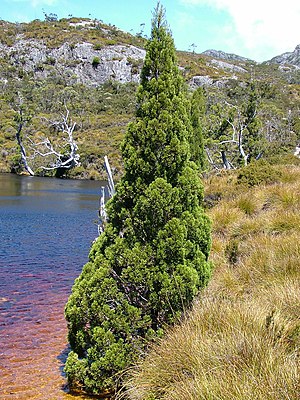Scaly spruce
| Scaly spruce | ||||||||||||
|---|---|---|---|---|---|---|---|---|---|---|---|---|

Cypress-like scaly spruce ( Athrotaxis cupressoides ) in Tasmania |
||||||||||||
| Systematics | ||||||||||||
|
||||||||||||
| Scientific name of the subfamily | ||||||||||||
| Athrotaxidoideae | ||||||||||||
| Quinn | ||||||||||||
| Scientific name of the genus | ||||||||||||
| Athrotaxis | ||||||||||||
| D. Don |
The athrotaxis ( Athrotaxis ), and Tasmanian cedar called, the only genus in the subfamily are Athrotaxidoideae within the family of the cypress family (Cupressaceae). The botanical name is derived from two Greek words: athros = standing crowded, and taxis = position, it refers to the cone scales or the leaves.
distribution
Scaled spruce is only found in the temperate rainforests of Tasmania .
description
The scaly spruce are evergreen trees ; they reach a stature height of 10 to 30 (rarely 40) m and trunk diameter of 1.0 to 1.5 (up to 2) m. The bark comes off in thin, long strips. They have thick, spreading branches. The thick, flaky leaves are all the same shape and are 3 to 14 mm long.
The scaly spruces are monoecious ( monoecious ). The kitten-shaped male cones are solitary. The spherical to egg-shaped female cones are made up of spiraling cone scales that lignify when ripe. The cone scales are triangular in shape and have a short stem. At the base of each cone scale 3 to 5 ovules usually develop, which stand on a transverse bulge. The elongated seeds have two similarly shaped, narrow wings. The seeds ripen within a year. The seeds are spread over the wind. The seedlings form two cotyledons ( cotyledons ).
use
The wood is long-lasting and was used extensively in Tasmania in the past, but the species are too rare today to be cut down. For example, shingles for roofing were made from it.
In areas with high rainfall , with mild winters and cool summers, such as the British Isles, the Pacific coast of North America and New Zealand, the species are also planted as ornamental trees. As far as we know, the species in Germany are not winter hardy.
Systematics
There are three Athrotaxis TYPES (or two species and a bastard):
- Cypress-like scale spruce or toothed scale spruce ( Athrotaxis cupressoides D. Don ): The leaves are short (3 to 5 mm). The cones are small (1 to 1.5 cm), they are pressed tightly against the branch. This species is found in western Tasmania (Launceston, Lake Saint Clair, Mount Field National Park) at altitudes between 640 and 1067 meters. The oldest specimen of the species is around 1000 years old.
- Sickle-shaped scaly spruce ( Athrotaxis selaginoides D. Don ): The leaves are longer than those of the other species (8 to 14 mm), they stick out from the branch. The cones are larger than in the other species (2 to 3 cm). Their area extends from the mountain regions of the central plateau to the west coast of Tasmania, at altitudes between 914 and 1219 m above sea level. NN. The oldest living tree of this species is 777 years old. The wood is very soft with a fine grain, it is very durable and weatherproof. It was used in boat building, for clapboards and to build bodies of musical instruments.
- Banded scaly spruce ( Athrotaxis × laxifolia Hook. ): It is a hybrid of Athrotaxis cupressoides × Athrotaxis selaginoides . The leaves are short (4 to 7 mm), they stick out from the branch. The cones are between their two parent species (1.5 to 2.5 cm) in size and appearance. They grow at altitudes between 900 and 1200 m above sea level. NN. The oldest known tree of this species is 1300 years old. The wood is soft and reddish.
swell
- Christopher J. Earle: Athrotaxis. In: The Gymnosperm Database. December 12, 2010, accessed October 20, 2011 .
- Walter Erhardt among others: The big pikeperch. Encyclopedia of Plant Names . Volume 2. Verlag Eugen Ulmer, Stuttgart 2008. ISBN 978-3-8001-5406-7
Web links
Individual evidence
- ↑ William Dallimore, Albert Bruce Jackson: A handbook of Coniferae and ginkgoaceae . 1966, London.
- ^ David Don: Description of two genera of the natural family of plants called Coniferae. Transact. Linn. Soc., Vol. 18, 1841, pp. 163-179.
- ↑ Armin Jagel, Veit Martin Dörken: The cones of the cypress family (Cupressaceae) - Part 1: Subfamilies Cunninghamioideae, Athrotaxoideae, Taiwanioideae, Sequoioideae, Taxodioideae. Communications from the German Dendrological Society, Vol. 100, 2015, pp. 161–176.
- ↑ a b c Walter Erhardt among others: The great pikeperch. Encyclopedia of Plant Names . Volume 2, pages 1230-1231. Verlag Eugen Ulmer, Stuttgart 2008. ISBN 978-3-8001-5406-7